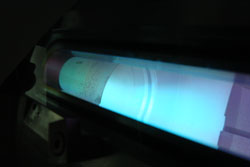A ‘plasma thruster’ will be developed for launch into space within the next four years, as part of a prototype satellite.
It will be the first time in seven years that a piece of Australian hardware will be sent into space and the first time a satellite with a plasma engine will be tested.
It is to be developed as a result of a three-way collaboration between the SP3 Group, EADS-Astrium and Surrey University that was formally established in March this year.
The European firm EADS-Astrium approached Dr Christine Charles and her colleagues in the Space Plasma Power and Propulsion (SP3) Group at the Australian National University (ANU) to work with the Surrey Space Centre at Surrey University in the UK to develop the new plasma thruster prototype.
The satellite will incorporate Dr Charles’ Helicon Double Layer Thruster (HDLT), which is an electrode-less magneto plasma thruster. Launched to low Earth orbit, the satellite will test its thrusting capacity in an orbital context.
Prof Rod Boswell, a department head of the ANU Plasma Research Laboratory, said that external funding was essential to get the prototype produced as Australia does not presently have a space programme.
For more information about Dr Charles’ plasma thruster, please click here.

Exhaust of the thruster in a laboratory experiment at ANU




Project to investigate hybrid approach to titanium manufacturing
What is this a hybrid of? Superplastic forming tends to be performed slowly as otherwise the behaviour is the hot creep that typifies hot...